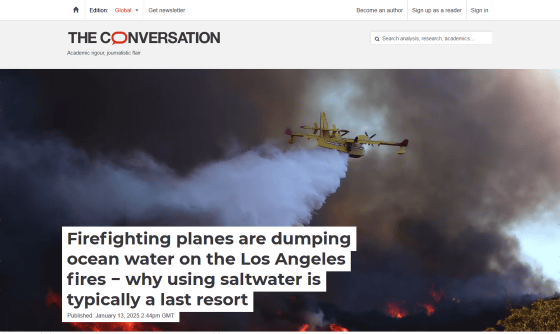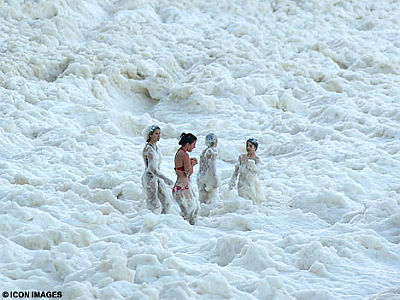The Los Angeles wildfire is running out of water, so an unusual firefighting operation is being carried out to spray 'seawater.' Why is seawater spraying the last resort?

In January 2025,
Firefighting planes are dumping ocean water on the Los Angeles fires − why using saltwater is typically a last resort
https://theconversation.com/firefighting-planes-are-dumping-ocean-water-on-the-los-angeles-fires-why-using-saltwater-is-typically-a-last-resort-247188

In the wildfires in Los Angeles, fire engines rushed to the scene, but due to a drop in water pressure in the fire hydrants and a depletion of water tanks, water did not come out of the hydrants, and after the water they had on board was used up , they could only watch the flames spread. It is said that this was because the power supply was cut off to ensure the safety of firefighters, and the pumps that pumped water were stopped, and the city's fire extinguishing system was not able to cope with large-scale wildfires.
Meanwhile, fire authorities are using an aerial fire extinguishing machine called the Super Scooper to pump up seawater and spray it from the air, an unusual form of firefighting activity. You can see how the Super Scooper actually pumps up seawater in the video below.
Firefighters battle Palisades wildfire with ocean water - YouTube
Although the solution of 'using abundant saltwater from the Pacific Ocean to put out wildfires' is very simple, it is still a last resort. One reason for this is that spraying saltwater on ecosystems such as forests that are not normally exposed to salt can have a negative impact, causing plants to die.
The effects of exposing forests to saltwater, whether through seawater spraying or storm surges, are not yet fully understood. To understand how forests that have not been exposed to salt for a long time react when exposed to saltwater, Megonigal is conducting an experiment called ' TEMPEST .'
In TEMPEST, saltwater and freshwater are pumped from the Chesapeake Bay on the Atlantic coast of the United States and stored in tanks, and forests in the experimental area are exposed to saltwater or freshwater until the soil is saturated, simulating high tides and flooding during a coastal storm.

by Smithsonian Environmental Research Center
As a result of the experiments, no significant impact was observed on the forest in an experiment in June 2022 in which the forest was exposed to salt water for 10 hours, and in an experiment in June 2023 in which the forest was exposed to salt water for 20 hours. However, when an experiment in June 2024 in which the forest was exposed to salt water for 30 hours was conducted, it was reported that the leaves of
The resilience of the forests observed in the series of experiments may have been due to the fact that the saltwater was pumped from the mouth of a river, so the salt content was relatively low. In addition, while rain fell after the experiments in June 2022 and June 2023, washing away the salt from the soil, a severe drought occurred after the experiment in June 2024, which may have contributed to the salt remaining in the soil.
In addition, Megonigal and his team pumped water from the forest soil exposed to salt water, and reported that the water turned brown about a month after the experiment and remained that way for two years, indicating that compounds were extracted from the dead plants in the soil. Other laboratory experiments suggest that salt also disperses and moves clay and other particles in the soil.

by Smithsonian Environmental Research Center
'While saltwater can help put out fires, there's a reason firefighting agencies prefer freshwater,' Megonigal said. 'Meanwhile, America's coastlines are facing more widespread and frequent saltwater exposure as sea levels rise at an accelerated rate due to rising global temperatures, inundating forests, fields and farms and posing unknown risks to our coastal landscapes.'
Related Posts:
in Science, Posted by log1h_ik







